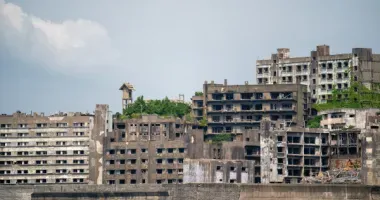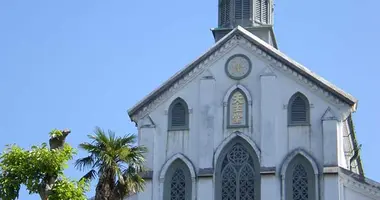Shofukuji & Fukusaiji Temples
Shofukuji Temple (聖福寺) & Fukusaiji Temple (福済寺), Nagasaki
Jake Davies
Nagasaki is well known for the culture and history of the Chinese who lived there during the "closed country" period and later.
As well as the Chinatown there is a big Confucian Shrine and two Chinese Buddhist temples, Sofukuji and Kofukuji that are popular tourist destinations and as such are well covered in guidebooks and other tourist literature.

Shofukuji Temple Gate, Nagasaki, Kyushu, Japan
There are however another couple of Chinese temples that are barely mentioned, but which, each in a quite different way, are well worth a visit and will reward those venturing a little off the main tourist track.
Whereas Sofukuji & Kofukuji are located in Teramachi, the line of temples along the south of the Nakashima River, Shofukuji & Fukusaiji are situated to the north of the river about halfway between Nagasaki Station and the new Museum of History & Culture.

Shofukuji Temple Main Building, Nagasaki, Kyushu, Japan

Shofukuji Temple wall
Shofukuji
Founded in 1677, Shofukuji is the 4th of the Nagasaki Chinese temples, though it was founded about 50 years after the first three. Each of the temples were established by Chinese from different areas of China, and Shofukuji was known as the Guandong (Canton) temple.
The first three temples were Ch'an Buddhist unaffiliated with any sect until after the Obaku sect was formed in 1661 and which they then proceeded to join, Shofukuji however, was founded right from the start as an Obaku temple.
Another difference is that the other three temples always had Chinese priests whereas Shofukuji was always served by Japanese priests. You will also notice some differences in appearance from the two more famous temples across the river, firstly there is no booth taking an entrance fee. Entry is free.
Next you may notice that there is much more greenery here. Lots of large, old trees, and no manicured open spaces, everything is somewhat overgrown and the stonework is covered in moss. The buildings here are also in a rather dilapidated state and sorely in need of repair, but that is the attraction of the place, a really serene green oasis in the city and literally oozing age.
The gate of Shofukuji was built in 1703, and up the flight of stone steps the first building you come to, the Tennoden was constructed in 1705. In this building you can see a large statue of a big, fat, laughing Buddha, Hotei, one of the shichifukujin, the 7 Lucky Gods.
He is sometimes considered, as is the case here, as a manifestation of Maitreya, the Future Buddha. Up another flight of stairs you come to the main hall, originally built in 1678 but rebuilt in 1715. Another difference you may notice between here and the other Chinese temples is that everything is left unpainted, there is little of the red color typical of the other two temples.
Though the architecture is still Obaku-Chinese in style. There are a couple of statues to be seen in the main hall, but a most intriguing sight can be found behind the main hall: a wall built out of roof tiles with other decorative ceramic pieces like onigawara (gargoyles) built in.
For the history buff there is a small monument to a woman named Oharu who was a half Japanese, half Italian young woman. When the Shogunate expelled all foreigners but the Dutch from Japan they also expelled all children who had been fathered by European men.

Hotei Statue, Shofukuji Temple, Nagasaki

Fukusaiji, Nagasaki
Fukusaiji
Leaving Shofukuji and carrying on along the road westwards, after another 200 meters a small side street leads up to the gate to Fukusai-ji. The gate is a modern concrete structure with a lion-dog's head sticking out of it, and on top of the gate a series of interlocking steel rings somewhat reminiscent of a gyroscope.
Looking like something that would not be out of place in front of a science museum or astronomical observatory its significance will become apparent after entering inside the temple.
Fukusai-ji was the second of the Chinese temples to be built in Nagasaki, being established in 1628, and it was in its day the largest of the Chinese temples. Known as Chang-Chow Temple after the region in China where the builders came from, there is nothing left of the original buildings as they were completely destroyed in the fires that spread after the atomic bomb blast.

Fukusaiji Temple Gate, Nagasaki
The new buildings were not completed until 1979. And after passing through the gate you will find yourself facing possibly the most unique temple building in Japan, a large concrete structure in the shape of a giant turtle. Protruding from the "shell" is a huge turtle's head made out of aluminum, and standing atop the shell is an 18 meter tall aluminum statue of Kannon, known popularly as the Goddess of Mercy.
The temple nowadays is often called the Nagasaki Kannon Universal Temple. As interesting as the main building is, there is something else unusual here. If you go into the main hall you will see a circular hole in the ceiling and a corresponding one in the floor.
A cable that starts in the head of the kannon statue on the roof passes down through the building to the basement below where it is attached to a golden sphere. This is a Foucault Pendulum, a device invented by the French physicist Léon Foucault (1819-1868) to show the rotation of the Earth.
Common at science museums and universities, this one was for a while the second largest in the world. It swings over a memorial to 16,000 war dead. As a reminder of the atomic bombing of Nagasaki in 1945 the temple bell sounds at 11.02 am, the exact time of the blast. Entry to the temple is free.

Fukusaiji, Nagasaki
Access - Getting to Shofukuji Temple & Fukusaiji Temple
Shofukuji Temple
3-77 Tamazonomachi, Nagasaki 850 0053
Tel: 095 823 0282
Fukusaiji Temple
2-56 Chikugomachi, Nagasaki 850 0052
Tel: 095 823 2663

Fukusaiji, Nagasaki
Book Hotel Accommodation in Nagasaki Japan
Books on Japan
Shofukuji & Fukusaiji: read guides to Shofukuji & Fukusaiji temples in Nagasaki, two important Chinese temples in the city.
















